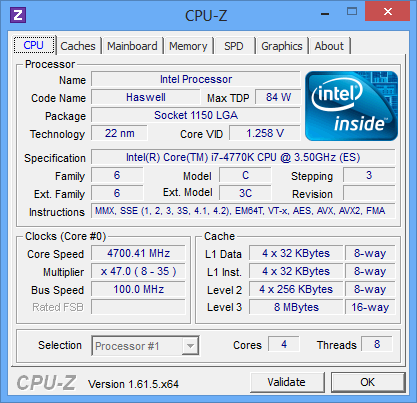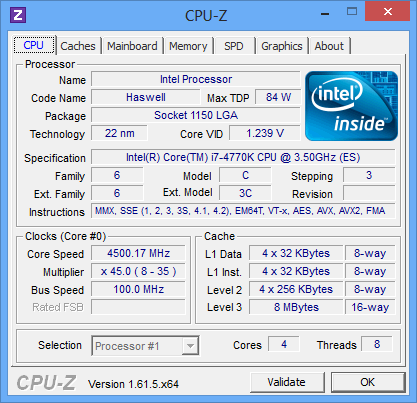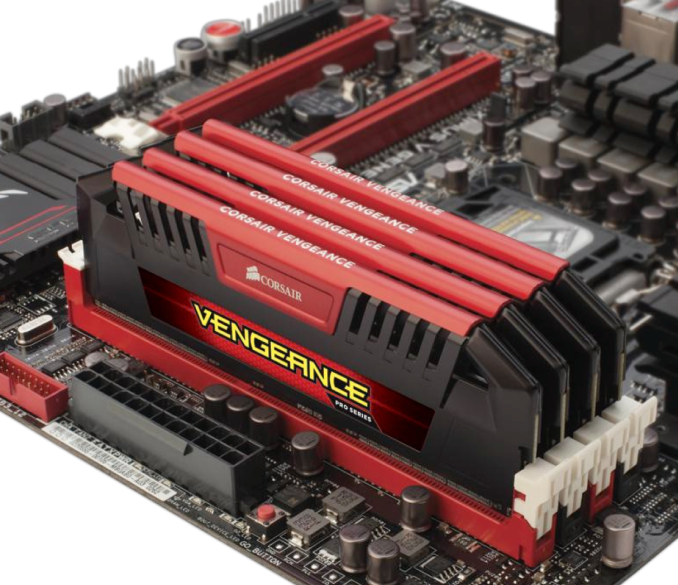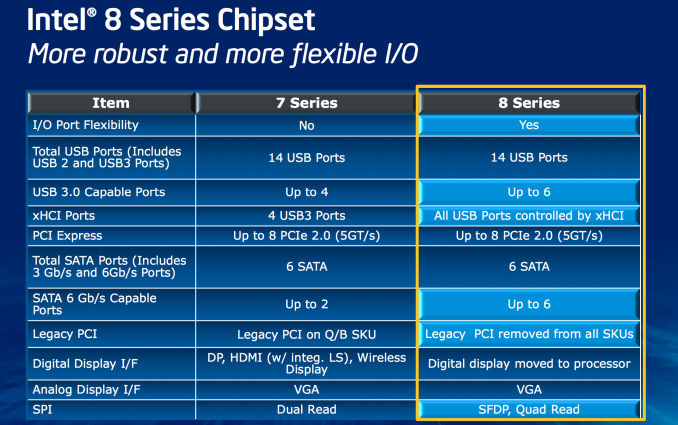The Haswell Review: Intel Core i7-4770K & i5-4670K Tested
by Anand Lal Shimpi on June 1, 2013 10:00 AM ESTMemory
Haswell got an updated memory controller that’s supposed to do a great job of running at very high frequencies. Corsair was kind enough to send over some of its Vengeance Pro memory with factory DDR3-2400 XMP profiles. I have to say, the experience was quite possibly the simplest memory overclocking I’ve ever encountered. Ivy Bridge was pretty decent at higher speeds, but Haswell is a different beast entirely.
Although I used DDR3-2400 for most of my testing, Corsair’s Vengeance Pro line is available in frequencies rated all the way up to 2933MHz.
Platform
Haswell features a new socket (LGA-1150). Fundamental changes to power delivery made it impossible to maintain backwards compatibility with existing LGA-1155 sockets. Alongside the new socket comes Intel’s new 8-series chipsets.
At a high level the 8-series chipsets bring support for up to six SATA 6Gbps and USB 3.0. It’s taken Intel far too long to move beyond two 6Gbps SATA ports, so this is a welcome change. With 8-series Intel also finally got rid of legacy PCI support.
Overclocking
Despite most of the voltage regulation being moved on-package, motherboards still expose all of the same voltage controls that you’re used to from previous platforms. Haswell’s FIVR does increase the thermal footprint of the chip itself, which is why TDPs went up from 77W to 84W at the high-end for LGA-1150 SKUs. Combine higher temperatures under the heatspreader with a more mobile focused chip design, and overclocking is going to depend on yield and luck of the draw more than it has in the past.
Haswell doesn’t change the overclocking limits put in place with Sandy Bridge. All CPUs are frequency locked, however K-series parts ship fully unlocked. A new addition is the ability to adjust BCLK to one of three pre-defined straps (100/125/167MHz). The BCLK adjustment gives you a little more flexibility when overclocking, but you still need a K-SKU to take advantage of the options.


In terms of overclocking success on standard air cooling you should expect anywhere from 4.3GHz - 4.7GHz at somewhere in the 1.2 - 1.35V range. At the higher end of that spectrum you need to be sure to invest in a good cooler as you’re more likely to bump into thermal limits if you’re running on stable settings.

















210 Comments
View All Comments
AmdInside - Sunday, June 2, 2013 - link
I am actually more interested in the new 8 series chipsets than Haswell. I have a Sandybridge work desktop and Ivybridge gaming desktop and would switch my Sandybridge motherboard if the chipset were backwards compatible with SB CPUs.Klimax - Sunday, June 2, 2013 - link
Just reminder: We are more or less out of free performance without new algorithms or massive complexity/power consumption. (There are limits to what we can do)And Intel engineers won't increase complexity of chips. (Otherwise they'd have their own version of GPU problems)
Anyway, waiting for Haswell-E... (Could use AVX2, but don't wont to lose 6 cores of 3930k)
ashetosvlakas - Sunday, June 2, 2013 - link
"As we’ve seen in the past, the K-series parts (and now the R-series as well) omit support for vPro, TXT, VT-d, and SIPP from the list."As this is the official Haswell review and since TSX are not included in the K-series parts, I believe this is a huge omission from the review, especially since transactional memory is a revolutionary technology with a lot of potential. I find the lack of mention misleading and it should be corrected as soon as possible.
KAlmquist - Sunday, June 2, 2013 - link
Thanks for letting us know this. Checking the specifications on ark.intel.com, I find:i5-4430 no TSX
i5-4570 has TSX
i5-4670 has TSX
i5-4670K no TSX
i7-4770 has TSX
i7-4770K no TSX
So TSX is missing from half of the current Haswell models (ignoring the low power S and T chips). So far we only have quad core chips; I expect that TSX will be missing from most of the dual core chips. It doesn't seem that TSX is intended to be used by developers writing general purpose code.
Kougar - Sunday, June 2, 2013 - link
Is 2016 the earliest we will see Haswell-E launch?Buying a 4770K means I'm wasting 33% of the die on a GPU I don't want, and because it's a "K" chip it will also lose VT-d capability. Six-core "K" chips retain VT-d support, but buying SB-E seems silly given Haswell offers much better IPC and single-threaded performance, and later even against IB-E it would feel like paying more for less.
Intel has taken a perpetual 2-year break between updating its high end, so if IB-E launches Q4'13 then it seems Q4'15 would be the earliest Haswell-E will show up?
Charlesm1950 - Sunday, June 2, 2013 - link
Haswell GT3e graphics come at what price? Certainly a lot more than Haswell GT2 or Richland A10 graphics. And Intel is right, Haswell GT3e graphics beats old, entry level discrete graphics cards. BUT, Haswell does not do DUAL GRAPHICS! Pair a Haswell with a dGPU and you get only the graphics horsepower of the dGPU. In short, you waste all that die area that Intel devoted to GT3e and eDRAM. On the other hand, pair a AMD Richland A10 with a dGPU and both GPUs work in tandem to give performance scores well beyond Haswell GT3e and for dare I say a lot less money. That's true even with the cheapest entry level Radeon GPU. So, Intel has created a monster graphics engine and put memory on the die - but to claim its free or the best solution is just being a fan boy for Intel.monohouse - Sunday, June 2, 2013 - link
this my friends, is a joke, the mighty Haswell K models will not support VT-x, LOL this is going to be the first nail in Intel's coffin in favor of AMD, and I bet AMD are going to take advantage of this (and they already take advantage of Intel's "K" marketing strategy - why buy an incredibly expensive Intel "K" model without VT-x support, when you can buy an AMD both unlocked and with VT-x support) (the joke is that a 5-year old Core 2 Duo has more to offer than the latest and greatest Intel parts [it supports VT-x]). I am running a 4300 mhz Wolfdale (Penryn) and an another 3000 mhz Conroe, none of what I see here (and in part due to the lack of VT-x support) from Haswell is of any significant enough value over my current hardware, I would have considered it if I had a Pentium 4, but even then I would rather go to the AMD side, since they present no obstacles.and I still have many functional PCI cards and I am not about to throw them away just because Intel decided not to support them (yet another nail in Intel's coffin) (in my opinion hardware has to comply with the user's wishes, not the other way around).
skrewler2 - Monday, June 3, 2013 - link
Wait, what? The K series doesn't include VT-d support, I don't see anything saying they don't support VT-x.BillyONeal - Monday, June 3, 2013 - link
Your comment doesn't make sense. AMD chips obviously don't have VT-x support; they have a competing standard, AMD-V. The first generation of virtualization extensions didn't make much of a dent in perf. The larger gains came as a result of SLAT which both AMD and Intel added around the Nehalem timeframe.monohouse - Sunday, June 23, 2013 - link
but SLAT is not going to be available on K models because virtualization is disabled ?